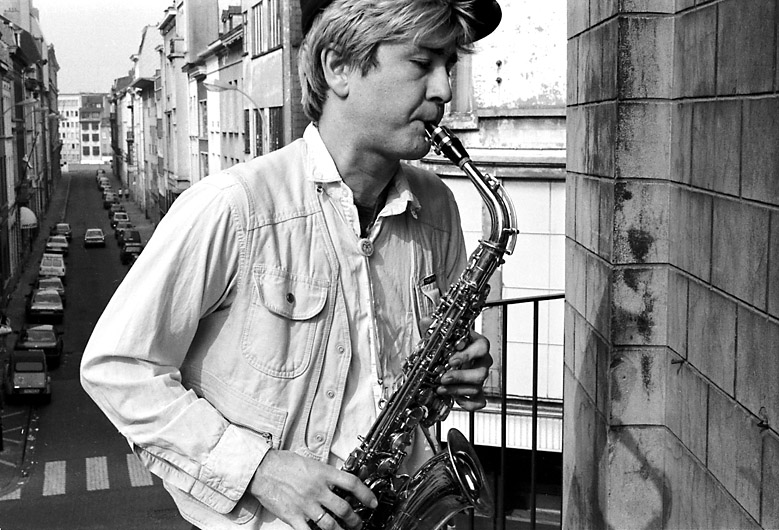Steven Brown \ Biography
Left-field American new wave band Tuxedomoon formed in San Francisco in 1977, initially around the creative nucleus of multi-instrumentalists Steven Brown and Blaine L. Reininger. Subsequently the duo were joined by bassist Peter 'Principle' Dachert. After signing with the cryptic Ralph label, home to The Residents, the band recorded the seminal albums Half Mute (1980) and Desire (1981), before relocating to Europe in order to pursue a more overtly avant-garde agenda. By now the group also included vocalist Winston Tong and visual director Bruce Geduldig.
The group moved first to Rotterdam, then Brussels. From their hectic concert and recording schedule between March 1981 and April 1983, four important recordings emerged, beginning with the score for a Maurice Bejart ballet in March 1982, released as Divine. The album Suite En Sous-Sol followed shortly afterwards, along with a trio of classic singles for Les Disques du Crépuscule: Ninotchka, Time to Lose and The Cage. The most ambitious project from 1982, an 'opera without words' called The Ghost Sonata, performed in Italy in July, remained unreleased until 1990.
Blaine L. Reininger left the band in April 1983, leaving Tuxedomoon to recruit Luc van Lieshout and plot their next move. The album Holy Wars emerged in 1985, followed by Ship of Fools (1986) and You (1987). The core Tuxedomoon trio of Brown, Reininger and Principle reunited for a successful world tour in 1988, and with Luc van Lieshout continue to perform and record. Ten Years In One Night (Live) (1990), Cabin in the Sky (2004), Bardo Hotel (2006), Vapour Trails (2007), Pink Narcissus (2014) and Blue Velvet Revisited (2015) bring the TM story up to date. A detailed biography, Music for Vagabonds by Isabelle Corbisier, was published in 2003.
Steven Brown began his solo career in 1983, with the first of two collaborative albums recorded with Benjamin Lew for Crammed Discs. Steven's first solo album proper, Music for Solo Piano, was released by Crépuscule in 1984 and remains one of his finest. Begun as a collaboration with Blaine Reininger, the album comprises ten pieces for piano, clarinet and violin, including Close Little Sixes, Waltz and r.w.f. - the latter an homage to German film director Rainer Werner Fassbinder. Much of the album was close in style to Music #2, the touchstone piano and violin duet recorded by Brown and Reininger in Tuxedomoon.
Steven's next project was the score for a production of Edward Albee's play The Zoo Story. His second solo album proper, Searching for Contact, offering more electronic textures than before, included a linked four-song cycle centered on Last Rendezvous, referencing the gay literature of Jean Genet and William S. Burroughs. The Italian language project Brown Plays Tenco also appeared in 1987.
In 1988 Reininger rejoined Tuxedomoon, alongside which he and Steven continued to work as a duo. The pair composed soundtracks for the film De Doute et de Grace, and the modern ballet score released as Croatian Variations. 1990 also saw a live album, Live in Lisbon.
Steven's third song-based solo album was the accomplished set Half Out, recorded for Crépuscule in 1991. Other releases include the soundtrack projects Music for Film and Theatre and La Grace du Tombeur, as well as band project Ninerain. In 1993 Steven relocated from Brussels to Mexico, and continues to record solo as well as with Tuxedomoon. Albums include Flower Songs (2006), El Informe Toledo (2009), Clear Tears (2013) and Monte Alban (2016). His score for the documentary film El Informe Toledo was nominated for an award by the Mexican Academy of Motion Picture Arts and Sciences.
Steven Brown online:
http://www.tuxedomoon.co




![DECADE (SELECTED WORKS 1982-92) [LTMCD 2344]](../images/ltmcd2344.jpg)
![MUSIC FOR SOLO PIANO [LTMCD 2357]](../images/ltmcd2357.jpg)
![SEARCHING FOR CONTACT [LTMCD 2362]](../images/ltmcd2362.jpg)
![HALF OUT [LTMCD 2412]](../images/ltmcd2412.jpg)
![BROWN PLAYS TENCO [LTMCD 2428]](../images/ltmcd2428.jpg)
![BLAINE L. REININGER & STEVEN BROWN LIVE IN LISBON 1989 [LTMCD 2431]](../images/ltmcd2431.jpg)
![Music For Film & Theatre [TWI 8722]](images/twi8722cd.jpg)
![MOVING SOUNDTRACKS [LTMCD 2514]](../images/ltmcd2514.jpg)
